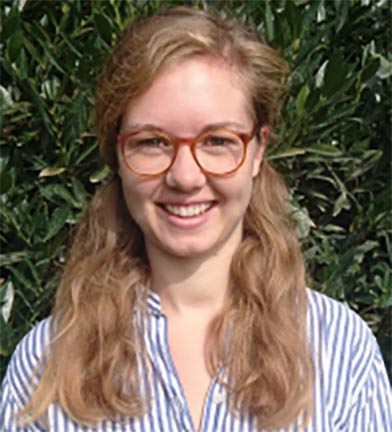
Curriculum Vitae
Oktober 2016 – jetzt – Candidata medicinae. Hämatologisch-onkologisches Forschungslabor des Universitätsklinikums, Jena. Dissertationstitel: Prävalenz und Dynamik BCR-ABL-unabhängiger Mutationen bei Patienten mit Chronischer Myeloischer Leukämie in der chronischen Phase
Oktober 2012 – jetzt – Studium der Humanmedizin (voraussichtlicher Abschluss: 10/2019) Friedrich-Schiller-Universität Jena
Oktober 2012 – jetzt – Stipendium der Studienstiftung des Deutschen Volkes
September 2014 Erster Abschnitt der Ärztlichen Prüfung
2004 – 2012 – E.T.A. Hoffmann-Gymnasium Bamberg, Abitur, Note: 1,2
Famulaturen und Arbeitserfahrung
Mai 2016 – jetzt Tutorin für Ultraschallkurse, Institut für Diagnostische und Interventionelle Radiologie, Universitätsklinikum Jena
Oktober 2014 – jetzt Mit Sicherheit Verliebt (Aufklärungsprojekt für Schülerinnen und Schüler)
Sept. – Okt. 2016 – Allgemeinmedizin, Hausärzte am Eichelberg, Burgebach
März – April 2016 – Kinderradiologie, Institut für Diagnostische und Interventionelle Radiologie, Universitätsklinikum Jena
Juli – August 2015 – Allgemein- und Seefahrtsmedizin Laegerne i Markstal (Dänemark)
März – April 2015 – Gastoenterologie, Kreiskrankenhaus Leer
Prävalenz und Kinetik BCR-ABL-unabhängiger Genmutationen bei CML Patienten in der chronischen Phase
Ruppert, L.; Rinke, J.; Waldau, A.; Hochhaus, A.; Ernst, T.
Klinik für Innere Medizin II, Universitätsklinikum Jena, Abteilung HÄmatologie/Onkologie, Jena, Germany
Introduction: Living without treatment has become a realistic aim for patients with chronic myeloid leukemia (CML) who chieved durable deep molecular remission under treatment with tyrosine kinase inhibitors (TKI). Recently, we have identified novel BCR-ABL independent gene mutations in newly diagnosed CML patients whereby mutations in epigenetic modifier genes were most common. However, prevalence, kinetics and prognostic significance of such mutations in a clinically well-characterized patient population need to be investigated systematically.
Methods: A total of 100 chronic phase CML patients from the German CML-V (TIGER) trial were investigated by targeted deep next-generation sequencing (NGS) covering 54 genes frequently mutated in myeloid malignancies. Paired samples at diagnosis and after 12 months of therapy were investigated to study mutation dynamics. If available, follow-up samples after 24 month (87/100 patients) and 36 months (39/100 patients) of therapy were also investigated.
Results: Thirty-five different mutations were detected in 32/100 patients (32%) affecting the genes ASXL1, BCOR, CALR, CUX1, DNMT3A, FBXW7, GATA2, IKZF1, JAK2, NOTCH1, RUNX1, STAG2, TET2, TP53, U2AF1 and WT1. ASXL 1 (n=13) and DNMT3A (n=5) were the most common mutations. in five patients more than one mutation was identified. 26/100 patients (26%) showed at least one mutation at diagnosis. Analysis of follow-up samples revealed that in 20 patients the mutations disappeared during TKI treatment. In 6 patients the mutation persisted indicating that the mutation preceded the BCR-ABL translocation. In 2/87 patients (2%) the initial mutation re-emerged at month 24 after disapperance at month 12; four of these mutations vanished and 8 persisted in further follow-up samples. So far, only one patiend showed a mutation first to emerge at month 24.
Conclusions: BCR-ABL independet gene mutations were frequently identified in chronic phase CML patients at diagnosis. In a minority of patients such mutations seem to precede the BCR-ABL translocation indicating a multistep pathogenesis in CML. BCR-ABL independent gene mutations were found to vary in their dynamics during TKI treatment and may function as important cofactors in the evolution and persistence of the disease.